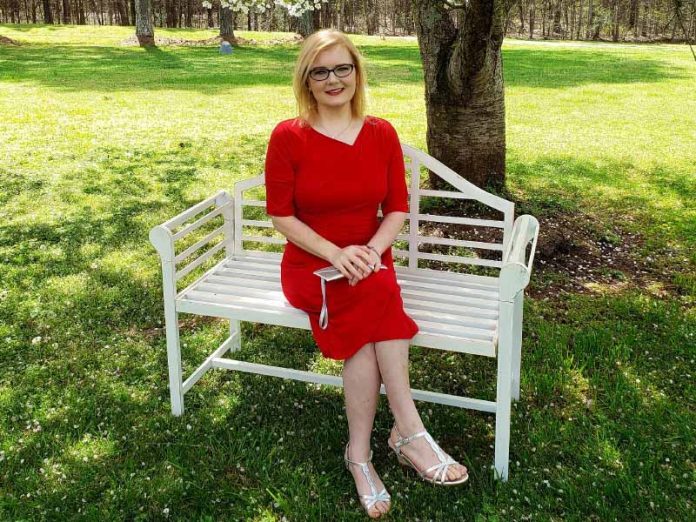
Jennifer Valentine’s colleague, longtime friend and neighbor Rebecca McCormack picked her up early at her home in York, South Carolina, for a ride to the airport.
The oncology technicians at a cancer center were off to a conference in Salt Lake City.
At the airport, they had breakfast at a fast-food restaurant before the 4.5-hour flight. Valentine ordered fried hashed browns and a gravy biscuit.
Such a rich breakfast was not Valentine’s recent routine. Two months earlier, she’d started exercising and eating more nutritious meals.
During much of her 35 years, Valentine’s weight had yo-yoed greatly. She had recently shed 12 pounds from a high of 229 (she’s 5-foot-6) and wanted to lose much more.
On the plane, the friends watched a comedy together. As they passed over the Rocky Mountains, Valentine took photos from her window seat.
Suddenly her breath became labored. She couldn’t understand why. She’d never been afraid of flying.
Just breathe normally, she told herself. Maybe this is what a panic attack feels like, she thought.
She told McCormack that she felt a fleeting pain in her left shoulder. Then Valentine went to the bathroom. While there, she became nauseous and then overheated.
Back in her seat, she started to shake so badly she couldn’t hold the orange juice she’d ordered.
McCormack helped her increase the ventilation above her head. She wondered if her friend could be having a heart attack but didn’t want to alarm her.
“Do you want me to call for help?” she asked Valentine.
“No, we’ll be there within an hour,” Valentine said. She didn’t want to make a commotion.
When they landed, McCormack carried her and Valentine’s bags. On the way to the terminal, Valentine became incredibly thirsty. She started to cry.
McCormack sat her down and got her some water.
Just as suddenly as they started, Valentine’s symptoms stopped.
At the hotel, Valentine went to take a nap. She called her husband to let him know what happened.
She got up to comb her hair and get ready to sign in at the conference. Once again, she felt out of breath.
She went to McCormack’s room in tears. They called a doctor at their workplace for advice.
“Get to urgent care or an ER now,” he told her.
At urgent care, a nurse performed an electrocardiogram. She tore the results off the machine and left the room. When she returned a few minutes later, she told Valentine: “An ambulance is on the way. You need to go to the ER.”
By this point, Valentine was feeling normal again.
An ultrasound and an echocardiogram showed no issues. When doctors said they were taking her to the cardiac catheterization lab for further diagnostic tests, Valentine protested, but ultimately relented.
An hour later, when they woke her up, a doctor told her she’d had a heart attack. He showed her two images.
One was of her right coronary artery, 100% blocked. Blood wasn’t flowing.
The other was after they placed a stent. Blood was flowing.
Doctors told Valentine that her heart attack was from a plaque rupture and that the cause was genetic. They also said she had a 65% blockage in her main coronary artery, but they would not place a stent until it became further blocked.
Valentine knew there were heart problems on her father’s side of the family but hadn’t been concerned.
“When you’re younger, you don’t think it will happen to you,” she said.
McCormack stayed with Valentine the first night at the hospital. Her husband arrived the next day. When they flew home together, she kept her eyes closed and her head on his shoulder.
Valentine was determined to continue to lose weight and exercise. Although she couldn’t change her genetics, she knew that becoming healthier would reduce her risk of heart disease.
But once she was home, she panicked.
“I felt like I was a ticking time bomb,” Valentine said. “Anytime I was trying to plan groceries, I’d just start crying. I didn’t even know what I could eat.”
She spoke with a nutritionist and started following recommendations from the American Heart Association. She restricted her sodium and saturated fat intake.
She changed her bread and flour from white to whole wheat. She cut out most processed foods. She also started walking daily.
Still, she was anxious about having another heart attack. She started to have panic attacks and took medication for anxiety and depression.
Sometimes she would go to bed at 7:30 p.m. after her husband, Jay, and their son, Blake, then 8, would finish dinner.
She credits one of the doctors at her practice with helping her talk through her anxiety, learning to relax and giving her a more positive outlook.
In the years since the heart attack, which happened in 2018, Valentine has lost 92 pounds. She now weighs 137. Last summer she stopped taking anxiety medication.
Valentine, now 40, frequently talks about her challenges and achievements on her TikTok page, where she has more than 19,000 followers.
“It’s been a great way to reach out and help other people,” she said.
Valentine also inspired McCormack to eat better and exercise more. The two often meet up at their local gym.
“I was a horrible eater, eating for convenience instead of for my body,” said McCormack, who also has heart disease in her family. “Watching Jennifer helped me learn to make better choices.”
Each helps the other strive toward a longer, healthier life.
“She still has her moments here and there, but she’s doing so much better,” McCormack said. “Mostly I feel fortunate to still have her here with me.”
Written by Diane Daniel.
If you care about heart health, please read studies about Aspirin linked to higher risk of heart failure, and how to remove plaques that cause heart attacks.
For more information about heart health, please see recent studies that Vitamin D deficiency can increase heart disease risk, and results showing Vitamin K2 could help reduce heart disease risk.



